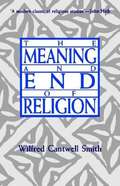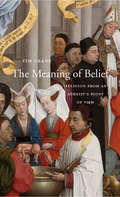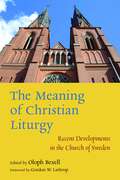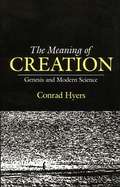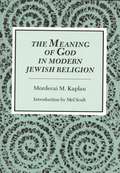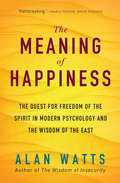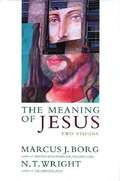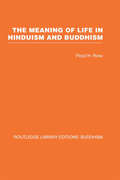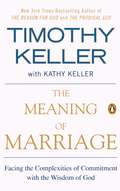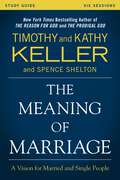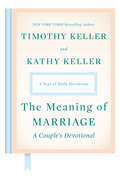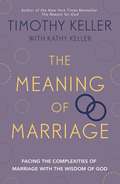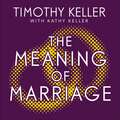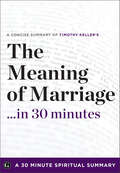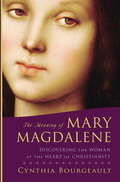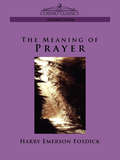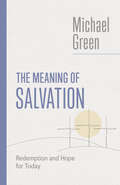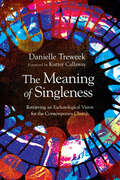- Table View
- List View
The Meaning And End Of Religion
by John Hick Wilfred C. SmithWilfred Cantwell Smith, maintained in this vastly important work that Westerners have misperceived religious life by making "religion" into one thing. He shows the inadequacy of "religion" to capture the living, endlessly variable ways and traditions in which religious faith presents itself in the world.
The Meaning of Belief: Religion from an Atheist’s Point of View
by Tim CraneCurrent debate about religion seems to be going nowhere. Atheists persist with their arguments, many plausible and some unanswerable, but they make no impact on believers. Defenders of religion find atheists equally unwilling to cede ground. Noting that religion is not what atheists think it is, Tim Crane offers a way out of this stalemate.
The Meaning of Christian Liturgy: Recent Developments in the Church of Sweden
by Oloph BexellThe Church of Sweden is the largest Lutheran church body in the world, with 6.5 million members that represent about 70% of the Swedish population. The Meaning of Christian Liturgy illuminates and explains the changes that have occurred in the liturgy of the Church of Sweden from 1980 to 2000. In the process, this volume asks a number of questions of immense importance not only within Sweden but also for Christian churches in the English-speaking world, including: How does participation in a liturgy make clear what "church" is about?What does liturgical participation say about who or what God is and about the community's encounter with God?How have churches lived with the changes and renewals introduced in the twentieth century?How does the church building shape worshipers' ideas of God and of church?Contributors:Torbjörn AxnerOloph BexellSven-Erik Brodd, Gordon W. LathropKarin OljelundBoel Hössjer SundmanGunnar Weman
The Meaning of Creation (Genesis and Modern Science)
by Conrad HyersAnyone who would propose to offer an interpretation of what the Genesis accounts of creation "really mean" must do so with considerable caution. There have been many different interpretations sent back to Europe, so to speak, not only of the meaning of the whole but of every verse, even every word. Perhaps this great variety of interpretation is an indication of the richness and subtlety of the creation stories themselves, which can suggest such a diversity of meanings. Perhaps, too, this variety is a reflection of the interpreters themselves, coming to these ancient texts from such a diversity of ages, cultures, philosophies, academic fields, methodologies, and religious persuasions. As in the case of the Dutch anthropologist, it is very easy to shape materials which come to us from a distant culture, language, and time to fit our own modes of thought and the issues that concern us.
The Meaning of God in Modern Jewish Religion
by Mel Scult Mordecai M. KaplanIn this book, Kaplan enlarges on his notion of functional reinterpretation and then actually applies it to the entire ritual cycle of the Jewish year-a rarity in modern Jewish thought. This work continues to function as a central text for the Reconstructionist movement, whose influence continues to grow in American Jewry.
The Meaning of Happiness: The Quest for Freedom of the Spirit in Modern Psychology and the Wisdom of the East
by Alan WattsDeep down, most people think that happiness comes from having or doing something. Here, in Alan Watts&’s groundbreaking third book (originally published in 1940), he offers a more challenging thesis: authentic happiness comes from embracing life as a whole in all its contradictions and paradoxes, an attitude that Watts calls the &“way of acceptance.&” Drawing on Eastern philosophy, Western mysticism, and analytic psychology, Watts demonstrates that happiness comes from accepting both the outer world around us and the inner world inside us — the unconscious mind, with its irrational desires, lurking beyond the awareness of the ego. Although written early in his career, The Meaning of Happiness displays the hallmarks of his mature style: the crystal-clear writing, the homespun analogies, the dry wit, and the breadth of knowledge that made Alan Watts one of the most influential philosophers of his generation.
The Meaning of Jesus
by Marcus J. Borg N. T. WrightWas Jesus born of a virgin? Did he know he was the Messiah? Was he bodily resurrected from the dead? Did he intentionally die to redeem humankind? Was Jesus God? Two leading Jesus scholars with widely divergent views go right to the heart of these questions and others, presenting the opposing visions of Jesus that shape our faith today.
The Meaning of Jesus: Two Visions
by Marcus J. Borg N. T. WrightLeading Jesus scholars from opposite ends of the theological spectrum offer their differing views of the life and teachings of Jesus, and present a candid discussion of what these differences mean for the faith of Christians today.
The Meaning of Life
by Jeffrey Hopkins Richard Gere His Holiness the Dalai LamaUsing the traditional Buddhist allegorical image of the Wheel of Life and the teaching of the twelve links of dependent origination, the Dalai Lama deftly illustrates how our existence, though fleeting and often full of woes, brims with the potential for peace and happiness. We can realize that potential by cultivating a wise appreciation of the interdependency of actions and experience, and by living a kind and compassionate life. A life thus lived, the Dalai Lama teaches, becomes thoroughly meaningful for both oneself and for others.
The Meaning of Life in Hinduism and Buddhism (Routledge Library Editions: Buddhism)
by Floyd H RossOriginally published in 1952. This volume, by discussing significant insights of Hinduism and Buddhism, answers the question "What is the meaning of life?" It illustrates the importance of Buddhist and Hindu teachings and their relevance to the West, as well as clarifying some of the religious and philosophical problems Western readers must grapple with.
The Meaning of Marriage
by Timothy KellerIn previous books respected New York pastor and bestselling author Timothy Keller has looked at such diverse and topical subjects as the existence of God, our need to do justice, the meaning of Jesus' life, and the human temptation to make idols - all through the twin lenses of a biblical framework and an engagement with contemporary culture. In this new book, co-authored with his wife, Kathy, he turns his attention to that most complex of matters: our need for love, and its expression in marriage. Beginning with the biblical narrative, and its pictures of marriage that span the original ideal to the broken to the redemptive, he looks at themes of friendship and commitment; the completion of men and women in each other; singleness, sex and divorce; and ministry and discipleship within the context of marriage. This is a profound and engaging work that will challenge and inspire people in all stages of life - single, newlywed and married.
The Meaning of Marriage
by Timothy KellerRenowned pastor of New York's Redeemer Presbyterian Church and author of the forthcoming Every Good Endeavor, Timothy Keller with his wife of 36 years, delivers The Meaning of Marriage, an extraordinarily insightful look at the keys to happiness in marriage that will inspire Christians, skeptics, singles, long-time married couples, and those about to be engaged. Modern culture would make you believe that everyone has a soul-mate; that romance is the most important part of a successful marriage; that your spouse is there to help you realize your potential; that marriage does not mean forever, but merely for now; that starting over after a divorce is the best solution to seemingly intractable marriage issues. All those modern-day assumptions are, in a word, wrong.Using the Bible as his guide, coupled with insightful commentary from his wife of thirty-six years, Kathy, Timothy Keller shows that God created marriage to bring us closer to him and to bring us more joy in our lives. It is a glorious relationship that is also the most misunderstood and mysterious. With a clear-eyed understanding of the Bible, and meaningful instruction on how to have a successful marriage, The Meaning of Marriage is essential reading for anyone who wants to know God and love more deeply in this life.Just as this book is based on his popular sermon series, so will his Encounters with Jesus series, the first of which, The Skeptical Student comes out in December.
The Meaning of Marriage
by Timothy KellerRenowned pastor of New York's Redeemer Presbyterian Church and author of the forthcoming Every Good Endeavor, Timothy Keller with his wife of 36 years, delivers The Meaning of Marriage, an extraordinarily insightful look at the keys to happiness in marriage that will inspire Christians, skeptics, singles, long-time married couples, and those about to be engaged. Modern culture would make you believe that everyone has a soul-mate; that romance is the most important part of a successful marriage; that your spouse is there to help you realize your potential; that marriage does not mean forever, but merely for now; that starting over after a divorce is the best solution to seemingly intractable marriage issues. All those modern-day assumptions are, in a word, wrong.Using the Bible as his guide, coupled with insightful commentary from his wife of thirty-six years, Kathy, Timothy Keller shows that God created marriage to bring us closer to him and to bring us more joy in our lives. It is a glorious relationship that is also the most misunderstood and mysterious. With a clear-eyed understanding of the Bible, and meaningful instruction on how to have a successful marriage, The Meaning of Marriage is essential reading for anyone who wants to know God and love more deeply in this life.Look out for Timothy and Kathy Keller's latest book, The Songs of Jesus, coming from Viking on November 10, 2015.From the Hardcover edition.
The Meaning of Marriage Study Guide: A Vision for Married and Single People
by Timothy Keller Kathy KellerTimothy and Kathy Keller will show you a portrait of marriage as it's meant to be according to the Bible...by first throwing out most of what we've been taught about love.Modern culture would have you believe that everyone has a soul mate; that romance is the most important part of a successful marriage; that marriage does not mean 'til death do us part, but merely for as long as my needs are being met; and that when serious differences arise, divorce is the best solution. But all of these modern-day assumptions miss what marriage is really about.In this six-session video-based Bible study (DVD/digital video sold separately), Timothy Keller, along with Kathy, his wife of forty years, draws a profound portrait of marriage from the pages of Scripture that neither idealizes nor rejects the institution but points us back to the relationship between God and man. The result is a vision for marriage that is refreshingly frank and unsentimental, yet hopeful and beautiful.This study is for anyone from singles to couples considering marriage to those who have been married for any length of time.Sessions include:Service: Marriage Isn't about YouCovenant: Created to Make PromisesRoles: Loving through Mutual SubmissionSingleness: Strengthening the Spiritual FamilySex: The Act of Covenant RenewalHope: Seeing the Great HorizonDesigned for use with The Meaning of Marriage Video Study (sold separately).
The Meaning of Marriage: A Year of Daily Devotions
by Timothy Keller Kathy KellerFrom pastor and New York Times bestselling author Timothy Keller comes a gorgeously packaged daily devotional that takes us on year-long journey into discovering the meaning of marriageMarriage is the most profound human relationship there is. Coming to know and love your spouse is one of the most rewarding and wondrous things we can experience in life. But it is also one of the most difficult and painful. In this 365-day devotional, Timothy Keller and his wife of forty-three years Kathy Keller share powerful instructions on how to have a successful marriage. The Kellers draw from and expand upon lessons they first introduced in their book The Meaning of Marriage, offering stories, daily scriptures, and prayer prompts that will inspire anyone who wants to know God and love more deeply in this life.
The Meaning of Marriage: Facing the Complexities of Commitment with the Wisdom of God
by Timothy Keller“Incredibly rich with wisdom and insight that will leave the reader, whether single or married, feeling uplifted.” —The Washington TimesBased on the acclaimed sermon series by New York Times bestselling author Timothy Keller, this book shows everyone—Christians, skeptics, singles, longtime married couples, and those about to be engaged—the vision of what marriage should be according to the Bible.Modern culture would have you believe that everyone has a soul mate; that romance is the most important part of a successful marriage; that your spouse is there to help you realize your potential; that marriage does not mean forever, but merely for now; and that starting over after a divorce is the best solution to seemingly intractable marriage issues. But these modern-day assumptions are wrong. Timothy Keller, with insights from Kathy, his wife of thirty-seven years, shows marriage to be a glorious relationship that is also misunderstood and mysterious. The Meaning of Marriage offers instruction on how to have a successful marriage, and is essential reading for anyone who wants to know God and love more deeply in this life.Look out for Timothy Keller's latest book, The Songs of Jesus.From the Trade Paperback edition.
The Meaning of Marriage: Facing the Complexities of Marriage with the Wisdom of God
by Timothy KellerIn previous books respected New York pastor and bestselling author Timothy Keller has looked at such diverse and topical subjects as the existence of God, our need to do justice, the meaning of Jesus' life, and the human temptation to make idols - all through the twin lenses of a biblical framework and an engagement with contemporary culture.In this new book, co-authored with his wife, Kathy, he turns his attention to that most complex of matters: our need for love, and its expression in marriage. Beginning with the biblical narrative, and its pictures of marriage that span the original ideal to the broken to the redemptive, he looks at themes of friendship and commitment; the completion of men and women in each other; singleness, sex and divorce; and ministry and discipleship within the context of marriage. This is a profound and engaging work that will challenge and inspire people in all stages of life - single, newlywed and married.
The Meaning of Marriage: Facing the Complexities of Marriage with the Wisdom of God
by Timothy KellerIn previous books respected New York pastor and bestselling author Timothy Keller has looked at such diverse and topical subjects as the existence of God, our need to do justice, the meaning of Jesus' life, and the human temptation to make idols - all through the twin lenses of a biblical framework and an engagement with contemporary culture.In this new book, co-authored with his wife, Kathy, he turns his attention to that most complex of matters: our need for love, and its expression in marriage. Beginning with the biblical narrative, and its pictures of marriage that span the original ideal to the broken to the redemptive, he looks at themes of friendship and commitment; the completion of men and women in each other; singleness, sex and divorce; and ministry and discipleship within the context of marriage. This is a profound and engaging work that will challenge and inspire people in all stages of life - single, newlywed and married.(P)2011 Penguin
The Meaning of Marriage . . . in 30 Minutes: A 30 Minute Spiritual Summary
by Timothy KellerThe Meaning of Marriage ...in 30 Minutes is your guide to quickly understanding the lessons in Timothy Keller's best-selling book, The Meaning of Marriage:Facing the Complexities of Commitment with the Wisdom of God. In The Meaning of Marriage, Timothy Keller uses the wisdom from his marriage of over thirty-seven years to explain how to increase the success of a Christian marriage. He posits that modern society creates expectations about marriage that are distorted and unrealistic, preventing married couples from finding true happiness. Using studies and statistics about marriage as well as the wealth of knowledge between him and his wife, Kathy Keller, the author challenges commonly held views on marriage, and proves that with hard work and realistic expectations, a marriage can be the most unique and glorious way to experience God's love on Earth. Use this helpful guide to understand The Meaning of Marriage in a fraction of the time, with tools such as: Practical applications for how to overcome everyday obstacles and create realistic expectations within a marriage Insights into the different roles men and women have in a Christian marriage Personal stories about marriage and the importance of faith in everything from sex to raising children to everyday chores A synopsis of The Meaning of Marriage, definitions of key terms, and both positive and negative critical reception of the book An overview of why modern culture's idea of a soul mate is wrong As with all books in the 30 Minute Expert Series, this book is intended to be purchased alongside the reviewed title, The Meaning of Marriage:Facing the Complexities of Commitment with the Wisdom of God.
The Meaning of Mary Magdalene: Discovering the Woman at the Heart of Christianity
by Cynthia BourgeaultMary Magdalene is one of the most influential symbols in the history of Christianity--yet, if you look in the Bible, you'll find only a handful of verses that speak of her. How did she become such a compelling saint in the face of such paltry evidence? In her effort to answer that question, Cynthia Bourgeault examines the Bible, church tradition, art, legend, and newly discovered texts to see what's there. She then applies her own reasoning and intuition, informed by the wisdom of the ages-old Christian contemplative tradition. What emerges is a radical view of Mary Magdalene as Jesus's most important disciple, the one he considered to understand his teaching best. That teaching was characterized by a nondualistic approach to the world and by a deep understanding of the value of the feminine. Cynthia shows how an understanding of Mary Magdalene can revitalize contemporary Christianity, how Christians and others can, through her, find their way to Jesus's original teachings and apply them to their modern lives.
The Meaning of Pentecost in Early Methodism: Rediscovering John Fletcher as John Wesley's Vindicator and Designated Successor
by Laurence W. WoodJohn Fletcher's theology of Pentecost is generally unknown today, and this book is the first comprehensive treatise on this subject. His writings were in large part responsible for shaping the theology of early American Methodism, especially his treatise on Christian Perfection, which highlighted a theology of Pentecostal sanctification. Wood recounts the decisive influence Fletcher had on early Methodism, and shows that his writings were able to "control the opinions of the largest and most effective body of evangelical clergymen of the earth. " Fletcher's views on the Holy Spirit were also relevant in the ecumenical movement, specifically with reference to the World Council of Churches Commission on Faith and Order held in Lima, Peru, in 1982. This group recommended the introduction of a liturgy of the Spirit in Christian baptism. For students and scholars or general readers interested in Methodist history and theology. Also a resource for pastors-helpful in developing a theology of Pentecost that will preach in a relevant way in the contemporary world.
The Meaning of Prayer
by Harry Emerson FosdickHarry Emerson Fosdick was one of the most popular liberal preachers of the early twentieth century, and his The Meaning of Prayer is considered by many one of the finest studies of the meditative communion with God. This lovely little book features daily devotional readings focused on understanding prayer, reflecting upon: . The Naturalness of Prayer . Prayer and the Goodness of God . Hindrances and Difficulties . Unanswered Prayer . Prayer as Dominant Desire . Unselfishness in Prayer and other issues arising from conversing with the divine. This warm, friendly guidebook to a profoundly personal act remains an important exploration of one of the world's dominant faiths... just as it was when it was first published in 1915. Also available from Cosimo Classics: Fosdick's The Manhood of the Master and The Meaning of Faith.
The Meaning of Salvation: Redemption and Hope for Today (The Eerdmans Michael Green Collection)
by Michael GreenMichael Green shines a light on salvation as it appears in Scripture and in our lives. In this perennial classic of soteriology, Michael Green explores the deeply human longing for salvation. But what did salvation mean to Jewish and Gentile people at the time of Jesus? Green traces salvation through the Old Testament, first-century Greco-Roman sources, and the New Testament. What emerges is the conviction that salvation is not just a hope for the future, but an offer of redemptive grace for the here and now. In a culture increasingly rife with despair and anxiety, Green&’s timeless work offers a message of hope in the good news of Jesus Christ. &“There are few ways in which the Church could better serve this generation than by recovery, a translation into modern idiom, and a bold proclamation of the wonderfully comprehensive message of salvation contained in the Scriptures.&”
The Meaning of Singleness: Retrieving an Eschatological Vision for the Contemporary Church
by Danielle TreweekIs Christian singleness a burden to be endured or a God-ordained vocation? Might singleness here and now give the church a glimpse of God's heavenly promises? Dani Treweek offers biblical, historical, cultural, and theological reflections to retrieve a theology of singleness for the church today. Drawing upon both ancient and contemporary theologians, including Augustine, Ælfric of Eynsham, John Paul II, and Stanley Hauerwas, she contends not only that singleness has served an important role throughout the church's history, but that single Christians present the church with a foretaste of the eschatological reality that awaits all of God's people. Far from being a burden, then, Christian singleness is among the highest vocations of the faith.
The Meaning of Suffering and Strife and Reconciliation (The Spiritual writings of Archimandrite Seraphi Aleksiev #Vol. II & III)
by Ralitsa DoynovaAlong with the current lack of belief and faith in God, truly the most piteous of all suffering is the lack of repentance--and therefore the lack of love. Repentance leads to the gateway of heaven and not only alleviates the anguish of suffering but actually transforms this suffering into the intense joy of being reunited with out Lord Jesus Christ.
